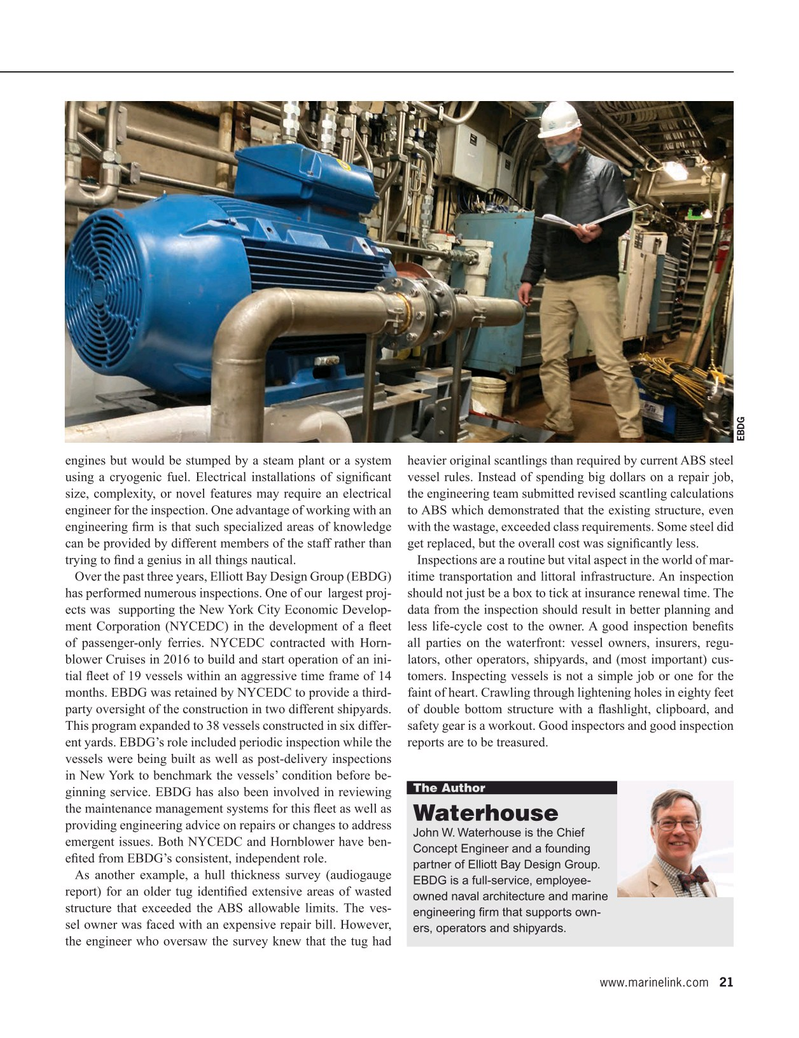
Page 21: of Maritime Reporter Magazine (June 2021)
USCG Fleet Modernization Annual
Read this page in Pdf, Flash or Html5 edition of June 2021 Maritime Reporter Magazine
EBDG engines but would be stumped by a steam plant or a system heavier original scantlings than required by current ABS steel using a cryogenic fuel. Electrical installations of signi? cant vessel rules. Instead of spending big dollars on a repair job, size, complexity, or novel features may require an electrical the engineering team submitted revised scantling calculations engineer for the inspection. One advantage of working with an to ABS which demonstrated that the existing structure, even engineering ? rm is that such specialized areas of knowledge with the wastage, exceeded class requirements. Some steel did can be provided by different members of the staff rather than get replaced, but the overall cost was signi? cantly less.
trying to ? nd a genius in all things nautical. Inspections are a routine but vital aspect in the world of mar-
Over the past three years, Elliott Bay Design Group (EBDG) itime transportation and littoral infrastructure. An inspection has performed numerous inspections. One of our largest proj- should not just be a box to tick at insurance renewal time. The ects was supporting the New York City Economic Develop- data from the inspection should result in better planning and ment Corporation (NYCEDC) in the development of a ? eet less life-cycle cost to the owner. A good inspection bene? ts of passenger-only ferries. NYCEDC contracted with Horn- all parties on the waterfront: vessel owners, insurers, regu- blower Cruises in 2016 to build and start operation of an ini- lators, other operators, shipyards, and (most important) cus- tial ? eet of 19 vessels within an aggressive time frame of 14 tomers. Inspecting vessels is not a simple job or one for the months. EBDG was retained by NYCEDC to provide a third- faint of heart. Crawling through lightening holes in eighty feet party oversight of the construction in two different shipyards. of double bottom structure with a ? ashlight, clipboard, and
This program expanded to 38 vessels constructed in six differ- safety gear is a workout. Good inspectors and good inspection ent yards. EBDG’s role included periodic inspection while the reports are to be treasured.
vessels were being built as well as post-delivery inspections in New York to benchmark the vessels’ condition before be-
The Author ginning service. EBDG has also been involved in reviewing the maintenance management systems for this ? eet as well as
Waterhouse providing engineering advice on repairs or changes to address
John W. Waterhouse is the Chief emergent issues. Both NYCEDC and Hornblower have ben-
Concept Engineer and a founding e? ted from EBDG’s consistent, independent role.
partner of Elliott Bay Design Group.
As another example, a hull thickness survey (audiogauge
EBDG is a full-service, employee- report) for an older tug identi? ed extensive areas of wasted owned naval architecture and marine structure that exceeded the ABS allowable limits. The ves- engineering ? rm that supports own- sel owner was faced with an expensive repair bill. However, ers, operators and shipyards. the engineer who oversaw the survey knew that the tug had www.marinelink.com 21
MR #6 (18-33).indd 21 6/3/2021 4:17:44 PM

 20
20

 22
22
